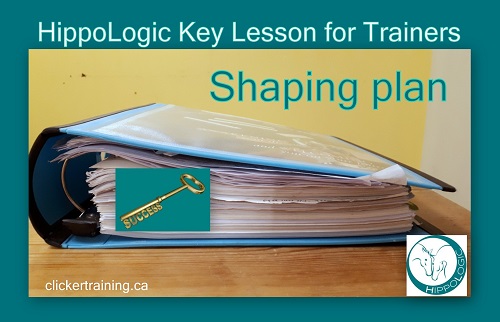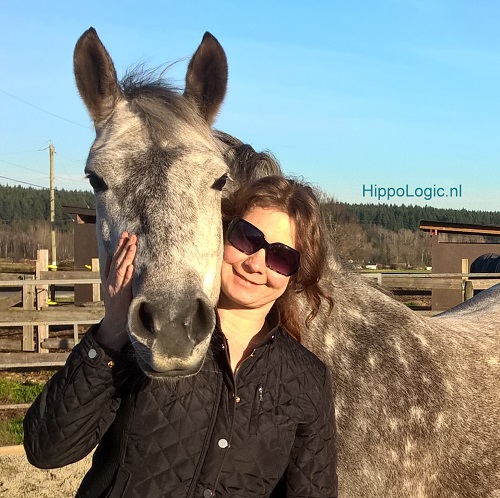In this blog I mention the 6 most common pitfalls for trainers that get or keep them stuck in clicker training their horse. Most horse owners have heard the phrase: Setting your horse up for Success, yet I see that they forget to set themselves!.
Pitfall #5: Forgetting to Set YOURSELF up for Success
Are you only thinking about your horse in training? How to serve him best?
Some people realize so well what their horse needs, in order to teach their horse a new behaviour quickly and without many detours. They know exactly how to help their horse to learn!
Yet, they forget what they need, in order to speed up their learning process or keep going with their training. They forget how to make training feel effortlessly and fun for themselves! This struggle often stays under the surface, because we don’t know what we don’t know, right?
It’s like when you discover how to learn to read a street map (or following instructions on Google Maps). Suddenly you realize how many times you’ve taken a detour and it explains why you’ve felt lost. I will share a tool that prevent this from happening. With this tool in hand these things won’t happen anymore!
You can set yourself up for success and speed up your learning process by avoiding making the same mistake over and over.
Reflect on your Training
The best way to learn is to reflect on your learning. Here are 5 tips that will help you do that:
- Track your Training with a Training journal
- Film your training session and watch your session
- Reflect back on your training with your Shaping plan
- Listen to feedback of your coach
- Count your training sessions and duration
Use an easy Training Journal
In the HippoLogic training system keeping a Training journal is on of the 6 Keys to Success for Trainers. I usually advice people to keep it very simple: just jot down 1-3 things that went well and only one learning point.
A learning point is the thing that you want to improve. Just writing down one is best. That’s the one you focus on in your next session or next training. Don’t write more than one, it can be challenging as it is to change or improve one thing.
Make Videos
When you film your sessions you can watch it back in the comfort of your own home. You literally can take distance from your training and that can help you stay more objective. Use your training journal to see what you thought went well and what you want to improve or focus on.
A video can also help a few weeks later to see your improvements or where you got stuck. What has changes in your horse or in your approach. We won’t remember it, but watching a video can be really motivating to see your progress.
I like to watch videos of my students so I can see what trainer and horse are doing. I can focus on details and watch it again or play it in slow motion to see if I’m missing an important clue.
Use your Shaping plan
The more you use your Shaping plan, the more value it gets. Reading through your plan just before you start your session and reading it afterwards to make adjustments, will help you become better and better at shaping behaviours. Write down your adjustments immediately, so you keep a record and don’t forget. Be detailed and also pay attention on environment (weather, things happening in surrounding of the horse) that might have influenced his behaviour. Your Shaping plan and Training journal can amplify your result when you use them together.
Ask for a second opinion or feedback from a coach
Getting feedback on your training or training videos from a coach or more experienced trainer can be of tremendous value. A fresh pair of eyes on your training will help you see what you don’t see. It can help you uncover your blind spots.
When you get stuck in training or you don’t see results as timely as you expected, find someone to help you. You don’t need to find out the wheel, make use of someone else’s experience so you can shorten your learning curve and help your horse better!
There are so many clicker coaches out there, it’s not hard to find someone that has experience with the behaviour you want to train.
Training sessions
Getting insights in how long it takes to train a behaviour or help your horse overcome a fear can help you put things in perspective. For instance if you tell yourself that you’ve been training to trailer load your horse for 3 months and you still can’t load him when you’re going home, have you really been training three months?
When you keep training in your Training journal about the times and dates you’ve been training you might discover that you started in week 1 and 2 very enthusiastically with 4 sessions of 30 minutes a week. After that something else became your focus and in week 3 and 4 you practised once for 15 minutes and then you didn’t train at all. Now you’re in week 12 and you forgot all about trailer loading. Your horse has moved and it’s off the radar… Until next time.

When you would count the training minutes it looks different. Let’s see: week 1 and 2: 4 hours in total, plus 2x 15 minutes in week 3 & 4 makes a total of 4, 5 hours. Four and a half hours is not the same as “three months”.
Now, let’s imagine you stopped practising trailer loading because your were very successful. It didn’t take you 2 or 3 months, just 4 and half hours to change your horse into a happy traveller. That’s encouraging isn’t it?
Keeping track of your training days and duration will also give you insight in your consistency in training. Whenever we (or our horses) learn a new skill, we thrive on consistency. Although I’m always pleasantly surprised about the memories of horses that are trained with positive reinforcement! They have excellent memory!
Emotions in Training
In the next blog I will focus on Emotions in Training, another Key to Success for Trainers. When you can recognize undesired emotions like frustration and redirect them into desirable emotions, training will be so much fun!

Read more:
- Pitfall #1 How to prevent Information Overload when you want to learn ‘Everything‘
- Pitfall #2 Turning vague goals into specific and clear training goals
- Pitfall #3 Focus on result and forgetting about How to get to the result (using R+)
- Pitfall #4 Quitting before seeing results and how to prevent that
Do more with Clicker Training!
Are you a compassionate horse owner who wants to build a strong friendship with your horse? Would you like to understand your horse better and help your horse to understand YOU better? Get access to high quality online training and a fabulous, supportive R+ community in our HippoLogic Clicker Training Academy. Check out the link!
Want to do more with Clicker Training?
Join the HippoLogic Academy! I coach and support you personally getting your dream results with positive reinforcement, so that you can bond with your horse in the process. Create a connection build on mutual trust and understanding, a clear two-way communication built on love. Click the image to go access the application form ↓

Not sure? Start with a free clicker training assessment to get taste of what it feels like to work with me. When you have a specific struggle that you want to overcome, don’t hesitate to contact me.
In this assessment you’ll discover what’s holding you back from accomplishing the things you want with your horse. After our conversation you’ll know exactly what to do, in order to move forward towards your goals.
Happy Horse training!
Sandra Poppema, B.Sc., founder of HippoLogic & HippoLogic Clicker Training Academy

Join us!

The Confident Clicker Trainer
In this 8-week online course you get personal coaching and support in a group. You’ll teach your horse 6 different foundational behaviours (Key Lessons for Horses, your keys to success in clicker training) and learn to use the 6 Success Keys for Trainers. This course is offered only a few times a year, don’t miss it!

















 because we (‘we’ = R+ trainers, instructor or not) present it like that (almost) all the time!
because we (‘we’ = R+ trainers, instructor or not) present it like that (almost) all the time! 
You must be logged in to post a comment.